09/11/23 - Spaniard rider-oganizer-writer Valenti Fontserè ...
At the recent Two Days of Trial Classic in Santigosa, the winner of the Trialer class was Valenti Fontserè, a 53-year-old civil engineer, known in our world for having produced together with the sadly deceased journalist Giulio Mauri a 312-page volume entitled “Trial Made in Italy 1975-1985”, with the whole history, embellished with hundreds of color photos of the numerous Italian Trial Factories of that decade, which we could define as the “golden era” of Trial.
His great fortune was to have been born and raised in Sant Felieu de Codines near Barcelona, ??a place where it would have been difficult not to be infected by the Trial disease. Home to the famous international Tres Dies des Cingles race, anyone who set foot in the days of that world event would have at least been fascinated by it. A long loop with 30 zones, the same for everyone like the Scottish, and therefore intelligently designed to attract more than 200 riders of all levels every year.
Valenti was intoxicated by the air he breathed and immediately immersed himself in our strange world. First with the trial bicycle, then with various motorbikes, but to a limited extent because it was conditioned by having to study engineering and then actively enter in a multinational in Barcelona, which boasts 130 years of activity with railway construction sites scattered all over the world.
Despite experiencing the Trial part-time, Valenti did it intensely, dealing with it with meticulousness - typical of engineers - and accuracy even for the more technical aspects. Not only as a rider, but also as an organiser, taking over the Three Days of Cingles for several years.
I had met him because, together with the two authors of the volume specified above, I was part of the winning team in the 2011 Two Days of Ventoux, all three of us riding Moto Guzzi Stornello, masterfully procured by the late Giulio.
Today Valenti - in the little free time his profession allows him - dedicates himself to some Vintage Trial races with more than excellent results. And it is precisely in what he considers among the most beautiful races in the world, the Two Days of Santigosa Classic, that it happened to meet us again, celebrating his extraordinary success in the Trialer class, the one with the green gates.
He remains a white fly, because he likes to use strictly vintage vehicles and with spare parts from the same era as that motorbike. He owns about fifty of them and personally carries out the restoration and maintenance. In favor of non-stop if it had started earlier, now it's too late...
This and much more in the answers to the general questions on how he sees the Trial in today's times preceded by the usual ones to introduce the character to the readers of phototrial.it.
When did you start in Trial? With what bike?
I started with Trialsin, Trial cycling in 1981. I did the European Championship from when it was created in '82 until the first World Championship in '85. I managed to come second in my class twice: in '82 and '84 where I won the Italian race organized by Giulio Mauri at Parco Sempione in Milan. There I ran with names like Andreu Codina, Thierry Girard, Jordi Tarrés, Amós Bilbao... all friends. A good school of life.
In '86, at the age of 16, I started riding motorbikes. because I tried to follow in the footsteps of Andreu Codina, a "brother" to me. We both come from Sant Feliu de Codines. He always helped me a lot. Our friendship has lasted for 40 years!
My first bike was a Montesa Cota 49 but I did my first races with the Montesa Cota 200 with Portús preparation. A bike that I recovered years ago and I am completely redoing. I wanted the motorbike and my father promised me to buy it if I achieved the best results in school. I did well, I liked studying but the goal was high...at Christmas I got the results and he kept his promise, as always.
Why the Trial? Who influenced your choice?
Because in Sant Feliu you could breathe Trial... The Three Days of the Cingles had the park closed in front of my school. From the living room of my grandmother's house you could see the riders climbing onto a large rock where all the champions have passed. We kids dreamed of this. In my house there wasn't a tradition but they always helped me and in the end they too became passionate about Trials to the point that my brother Joan worked with Andreu Codina and with the Octagon S2, he was responsible as Promoter of the World Championship, Indoor and Outdoor.
Your most important sporting results?
I didn't run at a high level for many years because I had started studying engineering and it was very demanding. I came third in the Spanish Junior Championship in '89 and should have moved up to Senior and turned professional like the first two did, but my future was in Engineering, so I continued racing for fun.
I also ran an edition of the Two Days of Brianza with the Spanish Federation Team together with Tarrés, Codina, Renales and Bilbao. A race that I really enjoyed.
And as an organizer?
In '95 I, Codina and a faithful group of friends, we took over the Moto Club Cingles. Codina was the President and I was the Deputy, his right-hand man. The previous management had run it for 20 years: now it was our turn. It was a great experience, which I recommend to all riders, so they can see the work that goes into it. After ten years we said it was enough... everything was too complicated. I also took care of the permits: it became a real nightmare.
Do you have any anecdotes from your racing era?
Yes, I would have many, let's see... It was the year '85 and the day before the Indoor Solo Moto I went during the school lunch break to see Codina who was fixing up his Cota 330 for the race. He tells me to try it and I tell him it's better not to for fear of something happening. He insists and I start taking steps and climbs: a real missile. Every time he makes me try steeper sections and I end up destroying his bike! “Don't worry,” Codina tells me. Tomorrow morning I'll go to Montesa and they'll fix it for me. Better to fall today than tomorrow! The next day, great victory for Codina in front of everyone. Perhaps his greatest victory.
What is your competitive activity today? I just saw a first place in Santigosa...
Yeahh, … pure fun. For years I have been doing one or two races a year, but always Santigosa. I had raced it for many years in the modern version of three days at Easter and it is very beautiful. Then for two years I have been doing it together with my son Max and with some friends.
I was very surprised by the Sherpa and I rode without errors but the result matters little to me. The aim is to spend two great days.
How many children do you have? What is your family made up of? Do they share your passion?
I am married to Glòria. We have 4 children: two girls, Adela and Pia, and two boys Max and Tsegaye. My boys love Trial and they practice it at their own level with their friends.
After many years there is a nice group of young people in Sant Feliu de Codines. This makes me so happy. Even my daughters have asked me to go for a ride on the trials bikes a few times, but always vintage ones.
What bikes have you owned and used?
Every year I ride Santigosa with a different bike and so I work on it throughout the year. This year I did it for the first time with a non-Italian bike, a 6-speed Bultaco and Max rode my Fantic 300. I raced with SWM, Garelli, Aprilia, Guzzi, Fantic. I won the scratch twice, in 2019 with an Aprilia Hiro 320 and this year with the Bultaco Sherpa 199B. All my motorbikes are strictly vintage and I only use the spare parts available at the time. For example, the Bultaco features the Bing carburettor and Betor shock absorbers. No special parts, no tubeless rims, no electronic ignition, etc. My philosophy is this and it is one more reason that pushes me to demonstrate that races can be done without hyper-prepared bikes, but I respect everything and everyone.
How many motorbikes do you have in your collection?
I don't know precisely. About fifty I think. I have everything in an Excel file - like a good engineer - with all the details, but it's not important...
Did you choose them for particular reasons?
I started with a nice SWM Guanaco because it was a bike that I had always liked and I hadn't been able to have, because I raced with Montesa and then Gas Gas. Then I decided to write the book “Trial Made in Italy 1975-1985” with Giulio Mauri and started collecting Italian motorcycles. At a certain point I decided to buy slightly particular motorbikes, which I liked.
I have a certain weakness for motorbikes with special English frames: for example, I have a Yamaha Majesty 320, a Kawasaki Gollner, a couple of Suzuki Beamish, a rare Ossa Gollner, a Sherpa Miller with the Hi-boy chassis and some Armstrong. All dual-suspension, except my Gas Gas Halley and the first single-suspension production motorcycle, the JCM 320.
The bikes must "transmit" something to me, so I am very happy to have an official SWM 320 prototype, Diego Bosis' Fantic 125 and Giulio Mauri's James.
How did you meet Giulio Mauri?
I met Giulio and Renata at the BMT European Championship in Valsassina. He was the organizer and also provided us with the famous Alpinestars boots. Then every year we saw each other and a few years later we met again at the Due Giorni della Brianza. In 2005 I contacted him again for my new project
How did the idea for the book on the Italian Trial come about? Why exactly that and that year range?
When I purchased the SWM Guanaco I saw that there were no books on Italian motorcycles, except for Mauri's Fantic-Michaud book. There was a lot of literature on English and Spanish motorcycles and I decided that this piece of history had to be written down. So in 2005 I called Giulio because I thought he should be involved. A quick lunch near Cadorna Station in Milan and off we go…
The idea was to publish the history of twin shock-absorbers vehicles and so we opted for that golden decade. We had other ideas in mind but unfortunately Giulio left too soon...
How many copies have you sold? Are there still any?
We printed 1000 in Italian and 1000 in Spanish. The Italian version is sold out and I still have a few dozen copies left of the Spanish one... oh by the way, if anyone is interested he can send me an email at trialmadeinitaly@gmail.com
How long did it take you to produce it?
Five years: it was very challenging because we wanted to make a good book and therefore talk to a lot of people. For me it was a life experience. From the first interview with Piero Kuciukian, to champions like Burgat, Schreiber, technicians like Seregni, Marqués, entrepreneurs like Sironi, Agrati,... everyone opened their doors to me and dedicated a lot of time to me. A beautiful relationship began with many of them which continues today.
Giulio was very busy with his multiple commitments and I had to push him a bit, but we worked very well together. We also spent some nice days with him and Renata. His house was like my home to me. Giulio was an "uncle" who passed down many things to me. His photographic archive is a treasure that I now keep at home. After her passing, Renata and her children told me that no one deserved to inherit her archive better than me, I take this opportunity to thank them again.
Was this your first and only experience in the publishing field?
It was the first. I wanted to make a book with the history of SWM and so I convinced my friend Mauro Sironi to do it. It also cost us a lot of time but in February 2020 we presented "SWM Story" at the Novegro Fair (MI), with the whole large SWM family present: Seregni, Burgat, Galeazzi, Tosco, Mangano, Franco Acerbis, Brissoni, Laureati and everyone the regularists. . A day not to forget. A week later the world stopped due to COVID!
I collaborated on other books, providing graphic material from Giulio's archive. For example for the book “Beta Story” where I lent a hand to Donato Miglio.
And in the journalistic field?
I have written several articles for motorcycle magazines. I write about what I like and with the archive I have it's easy to produce beautiful things. I collaborate, always as a hobby and without obligation. Trial Magazine and Classic Trial articles (French and English versions) and Offroad Vintage Vehicles have published articles on me. I try to write on slightly particular and original themes. The last article was on the history of the Mecatecno Trials.
Don't you want to write more books?
I'd like to continue writing some volumes but it's all very complicated and takes away your desire to do it. In addition to all the work involved, it is not easy to find a publishing house willing to print it. They ask you for money to do it or you have to do everything yourself.
For example, I translated the book TRIAL MADE IN ITALY 1975-1985 into English, spending time and money but for now no one is interested in printing and selling it. I don't ask for anything, just a certain number of volumes for me and that's it.
Who knows, maybe after this interview you will be contacted. Let's change subject.
How do you see the modern Trial?
Bad, I'm sorry but I'm sincere. Once upon a time - 40 years ago - anyone could participate in the national round of the World Championship. Now there are 9 of them in the top category. If I participated too, I would be among the Top 10! It doesn't make sense.
If you go to any long-loop race, there are 180-200 starters. The basic Trial is alive and overcomes the difficulties (environmentalists, costs of practicing it, etc.) but competition is the serious problem.
Why do you prefer the classic Trial?
Because I can't do the modern one. (laughing...). I'm joking but there is some truth. My children have modern motorbikes and I can't ride them well: too fast. Then the sections are dangerous and if you fall you get really hurt. At a certain age this is not good. If motorbikes are "missiles", the sections are more difficult and dangerous each time, like a vicious circle.
What about the regulations? For example, do you like no-stop?
The regulation certainly doesn't help but we should ask the masses, not the top riders who compete in the world championship. No-stop is like raising a child. If you don't scold him as he grows up, and then at 18 you want to educate him... it's too late. It should have been done from the beginning, but at that time few saw the problem and were accused of being retrograde.
Why are fewer motorcycles being sold? Too sophisticated? Too expensive? Is it too difficult to practice modern trials? Environmental restrictions?
I have friends in all the brands that make trials bikes and they all struggle. Once again it's a vicious circle. Fewer motorbikes are sold so the costs go up because the fixed costs have to be spread over fewer motorbikes, then if you sell the motorbike more expensively you have to justify it and therefore you make top of the range versions, when they are certainly not useful for many amateurs.
Once upon a time the trial motorbike was used for everything: to go around with friends, to go with the girlfriend or to get bread... Today the motorbike is only used to go to a closed area because if you don't risk of getting a fine. And society has also changed, young people have other dreams.
Why is the number of vintage trial practitioners increasingly numerous? What do they find there? Is it easier to learn? Do motorbikes and maintenance cost less?
It's a beautiful movement created years ago and the people who lived through that golden era have decided they want to recreate it. You find people you haven't seen for years, anyone can go and take part in the race they want (in Spain, in France, in Italy... even in Scotland). There is also a part in a festive atmosphere (see the Costa Brava).
But for me there is a risk: I hope it doesn't end like the no-stop!
There are some bikes that are too messy and high-performance, with the risk of the level rising. I've already heard some complaints in this regard. You need a nice vintage motorbike, well looked after. Furthermore, I see people in races who have bikes that are too powerful for their level and instead of helping them, penalize them!
What race did you do and did you like the most? Even more than one...
I really like the Two Days of Santigosa because I've been doing it since 1988, first the Three Days with the modern bike and now this one with the classics. The sections and landscape are beautiful.
Then every now and then I do a race abroad. I did the Due Giorni di Caglio, also very beautiful, a Due Giorni in Domodossola where I have some real friends, the Ventoux and also the SSDT pre'65 in 2016.
If you allow me, I'll tell you that I have good memories from Ventoux where I won in 2011 in the edition dedicated to Gilles Burgat, where I also worked hard to bring many big names to celebrate with Gilles. I won with two well-known journalists, again Giulio Mauri and a certain Mario Candellone, who had doubts about my level. In the end I was the best of the three (laughing...).
And then I have good memories of the pre-'65 SSDT, where I went with the ex-Giulio Mauri James that I bought from the family. We were planning to go with Giulio and unfortunately I went alone but I brought his motorbike as a tribute to him. When I faced the Pipeline with all the people screaming, I felt shivers!
Do you have other hobbies? Do you follow other sports?
Yes, many, let's say I'm not bored. In addition to Trial and motorbikes, I really like the sector's printed paper, I have many complete collections of magazines, both Spanish and foreign: from Solo Moto to Motocross, from French Moto Verte to Spanish Moto Verde, Moto Journal, Motosprint, Motociclismo, Vintage Motorcycling and some English magazines too.
Then one of my weaknesses are the original vintage Trial posters. I managed to get quite a few thanks also to many friends who gave me material and I bought others. I gradually frame them and they are all in my small shed where I have motorbikes and a workshop. If anyone has material to exchange or sell, let me know...
As a sport, I have always done a lot of cycling and swimming, to reduce stress and be fit for Trials. Only at an amateur level, no competitive spirit.
What will you do when you retire?
I'll tell you for sure what I won't do: go with the other pensioners to see the construction sites behind the barriers... (laughing...). I've seen them, and I see so many of them for work that I'm sure I'll be tired of them.
Health permitting, I hope to have time to do some motorbike restorations. Even though my background is not as a mechanical engineer, I have always liked mechanics a lot and I am learning. But I also have other interests: I really like architecture and reading, especially on modern topics, let's say after the Second World War. And when I say everything, I read everything: architecture, industry, politics, sport.
In fact, I have a sentence that I read in the presentation by Tommy Sandham, the English journalist who wrote two volumes on the history of the SSDT and the famous "Four Stroke Finale" or the history of the Honda trials, which I liked a lot. They ask him about his hobbies. After mentioning some of them he summarizes with: ".. living in the past!"
---------------------------------------------------------------------------------------
Lo spagnolo pilota-organizzatore-scrittore Valenti Fontserè ...
Alla recente Due Giorni di Trial Classic di Santigosa, a vincere la classe Trialer è stato Valenti Fontserè, un ingegnere civile 53-enne, noto nel nostro mondo per aver prodotto insieme al giornalista tristemente scomparso Giulio Mauri un volume di 312 pagine intitolato “Trial Made in Italy 1975-1985”,con tutta la storia, impreziosita di centinaia di foto a colori delle numerose Case da Trial italiane di quel decennio, che potremmo definire “epoca dell'oro” del Trial.
La sua grande fortuna è essere nato e cresciuto a Sant Felieu de Codines vicino a Barcellona, un luogo dove sarebbe stato difficile non venire contagiati dalla malattia del Trial. Sede della famosa gara internazionale Tres Dies des Cingles, chiunque avesse posato il piede nei giorni di quella kermesse mondiale ne sarebbe stato almeno affascinato. Un lungo giro con le 30 zone, uguali per tutti come la Scottish, e quindi intelligentemente tracciate per attirare tutti gli anni più di 200 piloti di tutti i livelli.
Valenti si è inebriato dell'aria che si respirava e si è subito tuffato nel nostro strano mondo. Prima con la bici-trial, poi con svariate moto, ma limitatamente perchè condizionato dal dover studiare ingegneria per poi entrare attivamente in una multinazionale di Barcellona, che vanta 130 anni di attività con cantieri ferroviari sparsi in tutto il mondo.
Pur vivendo il Trial part-time, Valenti lo ha fatto intensamente, occupandosene con pignoleria – tipica degli ingegneri – e accuratezza anche per gli aspetti più tecnici. Non solo da pilota, ma anche da organizzatore, rilevando per diversi anni quella della Tre Giorni del Cingles.
Lo avevo conosciuto proprio perchè insieme ai due autori del volume specificato sopra, ho fatto parte della squadra vincente nella Due Giorni del Ventoux del 2011, tutti a tre alla guida di Moto Guzzi Stornello, magistralmente procurate dal compianto Giulio.
Oggi Valenti - nel poco tempo libero che la sua professione gli concede - fa ogni tanto qualche gara di Trial d'epoca con risultati più che eccellenti. Ed è proprio in quella che considera tra le più belle gare del mondo, la Due Giorni di Santigosa Classic è capitato di incontrarci di nuovo, festeggiando il suo straordinario successo nella classe Trialer, quella con percorso verde.
Rimane una mosca bianca, perchè gli piace usare mezzi rigorosamente d'epoca e con ricambi della stessa epoca di quella moto. Ne possiede una cinquantina e provvede personalmente al restauro e alla manutenzione. Favorevole al no-stop se si fosse partiti prima, ora non è troppo tardi...
Questo e tanto altro nelle risposte alle domande generali su come vede il Trial nei giorni nostri precedute da quelle di rito per introdurre il personaggio ai lettori di phototrial.it.
Quando hai iniziato nel Trial? Con che moto?
Ho iniziato con il Trialsin, Trial in bicicletta nel 1981. Ho fatto il Campionato Europeo da quando si è creato nel ’82 fino al primo Mondiale nel ’85. Sono riuscito ad arrivare secondo di classe due volte: nel ’82 e nel ’84 dove ho vinto la gara italiana organizzata da Giulio Mauri al Parco Sempione di Milano. Lì correvo con nomi come Andreu Codina, Thierry Girard, Jordi Tarrés, Amós Bilbao… tutti amici. Una buona scuola di vita.
Nel ’86 a 16 anni ho iniziato con le moto. perché provavo a seguire i passi di Andreu Codina, un “fratello” per me. Entrambi arriviamo da Sant Feliu de Codines. Mi ha sempre aiutato tanto. La nostra amicizia dura da 40 anni!
La mia prima moto è stata un Montesa Cota 49 però le prime gare le ho fatte con il Montesa Cota 200 con preparazione Portús. Una moto che ho ricuperato anni fa e sto rifacendo completamente. Io volevo la moto e mio padre mi promise di comprarla se avessi raggiunto il massimo dei risultati a scuola. Andavo bene, mi piaceva studiare ma il traguardo era alto...a Natale ottenni i risultati e lui mantenne la promessa, come sempre.
Perchè il Trial? Chi ha influito sulla tua scelta?
Perché a Sant Feliu si respirava Trial… La Tre Giorni dels Cingles aveva il parco chiuso davanti alla mia scuola, Dal soggiorno di casa di mia nonna si vedevano i piloti salire su una grande roccia dove ci sono passati tutti i campioni . Noi ragazzi sognavamo questo. A casa mia non c’era una tradizione ma mi hanno sempre aiutato e alla fine anche loro si sono appassionati di Trial al punto che mio fratello Joan ha lavorato con Andreu Codina e con la Octagon S2 è stato responsabile come Promoter del Campionato Mondiale, Indoor e Outdoor.
I tuoi risultati sportivi più importanti?
Non ho corso tanti anni ad alto livello perché avevo iniziato gli studi di Ingegneria ed era molto impegnativo. Sono arrivato terzo al Campionato Spagnolo Junior nel ’89 e avrei dovuto passare Senior e diventare professionista come hanno fatto i primi due, ma il mio futuro era nell'Ingegneria, così ho continuato a correre per puro divertimento.
Ho corso anche un'edizione della Due Giorni della Brianza con il Team della Federazione Spagnola assieme a Tarrés, Codina, Renales e Bilbao. Una gara che mi è piaciuta tantissimo.
E come organizzatore?
Nel ’95 io, Codina e un fido gruppo di amici. abbiamo preso in mano il Moto Club Cingles. Codina era il Presidente e io il Vice, il suo braccio destro. La direzione precedente lo aveva gestito per 20 anni: ora toccava a noi. È stata una bella esperienza, che consiglio a tutti i piloti, così vedono il lavoro che c’è dietro. Dopo dieci anni abbiamo detto basta… troppo complicato tutto. Io mi occupavo anche dei permessi: era diventavo un vero incubo.
Hai qualche aneddoto della tua epoca di gare?
Sí, ne avrei tanti , vediamo ... Correva l’anno ’85 ed il giorno prima dell’Indoor Solo Moto vado nella pausa pranzo di scuola a vedere Codina che stava sistemando la sua Cota 330 per la gara. Mi dice di provarla e gli dico che è meglio di no per paura che succeda qualcosa. Lui insiste e comincio a fare dei gradini e dei salitoni: un vero missile. Ogni volta mi fa provare tratti più ripidi e finisco per distruggergli la moto! “Non preoccuparti”, mi dice Codina. Domattina vado in Montesa e me la sistemano. Meglio cadere oggi che domani! L’indomani grande vittoria di Codina davanti a tutti. Forse la più grande sua vittoria.
Qual è la tua attività agonistica oggi? Ho appena visto un primo posto a Santigosa...
Mahhh, … puro divertimento. Da anni faccio una-due gare all’anno, ma sempre Santigosa. L’avevo corsa per tanti anni nella versione moderna di tre giorni a Pasqua ed è molto bella. Poi da due anni la faccio assieme a mio figlio Max e con degli amici.
Sono rimasto molto sorpreso della Sherpa e ho guidato senza errori però il risultato mi importa poco. Lo scopo e passare due giornate alla grande.
Quanti figli hai? Com'è composta la tua famiglia? Condividono la tua passione?
Sono sposato con Glòria. Abbiamo 4 figli: due femmine, Adela e Pia, e due maschi Max e Tsegaye. I miei figli amano il Trial e lo praticano ognuno al suo livello con i propri amici.
Dopo tanti anni c’è un bel gruppo di giovani a Sant Feliu de Codines. Questo mi fa tanto piacere. Anche le mie figlie mi hanno chiesto di fare qualche volta di fare un giro con le moto di trial, sempre d’epoca però.
Quali moto hai avuto e utilizzato?
Ogni anno faccio Santigosa con una moto diversa e così ci lavoro durante tutto l’anno. Quest’anno l’ho fatta per la prima volta con una moto non italiana, un Bultaco 6 marce e Max ha guidato la mia Fantic 300. Ho corso con delle SWM, Garelli, Aprilia, Guzzi, Fantic. Ho vinto due volte lo scratch, nel 2019 con un Aprilia Hiro 320 e quest’anno con il Bultaco Sherpa 199B. Tutte le mie moto sono rigorosamente d’epoca e uso solo i ricambi disponibili all’epoca. Per esempio, il Bultaco monta il carburatore Bing e i gli ammortizzatori Betor. Niente pezzi speciali, niente cerchi tubeless, niente accensione elettronica, ecc. La mia filosofia è questa ed è un motivo in più che mi spinge a dimostrare che si possono fare le gare senza moto iper preparate, ma rispetto tutto e tutti.
Quante moto hai per collezione?
Non so con precisione. Una cinquantina penso. Ho tutto in un file Excel - da buon ingegnere - con tutti i dettagli, ma non è importante ...
Le hai scelte per motivi particolari?
Ho cominciato con un bel SWM Guanaco perché era una moto che mi era sempre piaciuta e non avevo potuto avere, perché correvo con Montesa e poi Gas Gas. Poi ho deciso di scrivere il libro “Trial Made in Italy 1975-1985” con Giulio Mauri e ho cominciato a collezionare moto italiane. A un certo punto ho deciso di acquistare moto anche un po' particolari, che mi piacevano.
Ho una certa debolezza per le moto con telai speciali inglesi: per esempio, ho una Yamaha Majesty 320, un Kawasaki Gollner, un paio di Suzuki Beamish, una rara Ossa Gollner, un Sherpa Miller con il telaio Hi-boy e qualche Armstrong. Tutte bi-ammortizzate, tranne le mie Gas Gas Halley e la prima moto di serie mono ammortizzata, la JCM 320.
Le moto mi devono “trasmettere” qualcosa, per cui sono molto contento di avere un prototipo SWM 320 ufficiale, il Fantic 125 di Diego Bosis e la James di Giulio Mauri.
Come hai conosciuto Giulio Mauri?
Ho conosciuto Giulio e Renata al Campionato Europeo di BMT in Valsassina. Lui era l’organizzatore e anche ci procurava i famosi scarpini Alpinestars. Poi ogni anno ci vedevamo e qualche anno dopo ci siamo ritrovati alla Due Giorni della Brianza. Nel 2005 l’ho ricontattato per il mio nuovo progetto
Come è nata l'idea del libro sul Trial Italiano? Perchè proprio quello e quella fascia di anni?
Quando ho acquistato l' SWM Guanaco ho visto che non c’erano libri sulle moto italiane, fatta eccezione per il libro Fantic-Michaud di Mauri. C’era molta letteratura sulle moto inglesi e quelle spagnole e ho deciso che si doveva mettere per iscritto questo pezzo di storia. Così nel 2005 ho chiamato Giulio perché ritenevo che lui dovesse essere coinvolto. Un pranzo veloce vicino a Stazione Cadorna a Milano e via…
L’idea era pubblicare la storia delle bi-ammortizzate e così abbiamo optato per quel decennio d’oro. Avevamo altre idee in testa però purtroppo Giulio se ne andò troppo presto…
Quante copie avete venduto? Ce ne sono ancora?
Ne abbiamo stampate 1000 in Italiano e 1000 in Spagnolo. La versione italiana è esaurita e di quella spagnola me ne rimane qualche decina di copia ancora… ah proposito se qualcuno fosse interessato può scrivermi a trialmadeinitaly@gmail.com
Quanto avete impiegato a produrlo?
Cinque anni: è stato molto impegnativo perché si è voluto fare un bel libro e quindi parlare con tantissima gente. Per me è stata un' esperienza di vita. Dalla prima intervista a Piero Kuciukian, a campioni come Burgat, Schreiber, tecnici come Seregni, Marqués, imprenditori come Sironi, Agrati,.. tutti mi hanno aperto le loro porte e mi hanno dedicato tanto tempo. Con molti di loro è iniziato un bel rapporto che continua ancora oggi.
Giulio era molto preso dai suoi multipli impegni e ho dovuto pressarlo un po', ma abbiamo lavorato benissimo insieme. Anche con lui e Renata abbiamo passato delle belle giornate. Casa sua era come se fosse casa mia per me. Giulio è stato uno “zio” che mi ha tramandato tante cose. Il suo archivio fotografico è un tesoro che adesso custodisco a casa. Dopo la sua scomparsa, Renata e i suoi figli mi hanno detto che nessuno meglio di me meritava di ereditare il suo archivio, colgo l’occasione per ringraziarli ancora.
Era la tua prima e unica esperienza in campo editoriale?
È stata la prima. Volevo fare un libro con la storia della SWM e così ho convinto l’amico Mauro Sironi a farlo. Ci è costato anche parecchio tempo ma a febbraio 2020 abbiamo presentato “SWM Story” alla Fiera di Novegro (MI), con tutta la grande famiglia SWM presente: Seregni, Burgat, Galeazzi, Tosco, Mangano, Franco Acerbis, Brissoni, Laureati e tutti i regolaristi. . Una giornata da non dimenticare. Una settimana dopo il mondo si fermava per il COVID!
Ho collaborato in altri libri, fornendo del materiale grafico dell’archivio di Giulio. Ad esempio per il libro “Beta Story” dove ho dato una mano a Donato Miglio.
E in campo giornalistico?
Ho scritto parecchi articoli per riviste di moto. Scrivo di quello che mi piace e con l’archivio che ho è semplice produrre belle cose. Collaboro, sempre come hobby e senza impegno. Mi hanno pubblicato articoli Trial Magazine e Classic Trial (versioni francese ed inglese) e Fuoristrada d’Epoca. Provo a scrivere su temi un po' particolari e originali. L’ultimo articolo è stato sulla storia delle Mecatecno Trial.
Non vorresti scrivere altri libri?
Mi piacerebbe continuare a scrivere qualche volume però è tutto molto complicato e ti tolgono la voglia di farlo. Oltre a tutto il lavoro che c'è, non è facile trovare una Casa Editrice disposta a stamparlo. Ti chiedono dei soldi per farlo o devi fare tutto da te.
Ad esempio, ho tradotto in inglese il libro TRIAL MADE IN ITALY 1975-1985, spendendo tempo e soldi ma per adesso nessuno è interessato a stamparlo e venderlo. Io non chiedo nulla, soltanto un certo numero di volumi per me e basta.
Chissà che dopo questa intervista tu non venga contattato. Cambiamo argomento.
Come vedi il Trial moderno?
Male, mi dispiace ma sono sincero. Una volta – 40 anni fa – chiunque poteva partecipare alla prova nazionale del Mondiale. Adesso sono in 9 nella massima categoria. Se partecipassi anch'io, sarei fra i Top 10! Non ha senso.
Se vai a qualsiasi gara di lunga durata, ci sono 180-200 partenti. Il Trial di base è vivo e supera le difficoltà (ambientalisti, costi per praticarlo, ecc.) ma la competizione è il grave problema.
Perchè preferisci il Trial classico?
Perché non riesco a fare quello moderno. (ridendo...). Scherzo ma c'è della verità. I miei figli hanno moto moderne e io non riesco a guidarle bene: troppo spinte. Poi le zone sono pericolose e se cadi ti fai veramente male. A una certa età questo non va bene. Se le moto sono dei “missili”, le zone sono ogni volta più difficili e pericolose, come un circolo vizioso.
Cosa mi dici dei regolamenti? Per esempio il no stop ti piace?
Il regolamento sicuramente non aiuta ma bisognerebbe chiedere alla massa, non ai piloti top che fanno il mondiale. Il Non-stop è come l’educazione di un figlio. Se tu non lo rimproveri man mano che cresce, e poi a 18 anni vuoi educarlo… è troppo tardi. Si doveva fare dagli inizi però a quell’epoca pochi vedevano il problema e venivano accusati di essere retrogradi.
Come mai si vendono meno moto? Troppo sofisticate? Troppo costose? Troppo difficile praticare il Trial moderno? Le restrizioni ambientali?
Io ho amici in tutti i marchi che producono moto da trial e tutti fanno fatica. Ancora un’altra volta è un circolo vizioso. Si vendono meno moto quindi i costi salgono perché quelli fissi si devono spalmare su meno moto, poi se la moto la vendi più cara lo devi giustificare e quindi fai versioni top di gamma. quando sicuramente non servono per tanti amatori.
Una volta la moto di trial , la si usava per tutto: per girare con gli amici, per andare con la fidanzata o a prendere il pane… Oggi la moto serve solo per andare in una area chiusa perché se non rischi di prendere la multa. E anche la società è cambiata, i giovani hanno altri sogni.
Perchè invece il numero di praticanti del trial vintage è sempre più numeroso? Cosa ci trovano? E' di più facile apprendimento? Costano meno le moto e la manutenzione?
È un bel movimento creato anni fa e la gente che ha vissuto quell’epoca d’oro ha deciso che vuole ricrearla. Trovi gente che non vedevi da anni, qualsiasi può andare a partecipare alla gara che vuole (in Spagna, in Francia, In Italia… pure in Scozia). C’è una parte anche in clima di festa (vedi il Costa Brava).
Però per me c’è un rischio: spero non finisca come con il no-stop!
Ci sono delle moto che sono troppo pasticciate e performanti, con il rischio che il livello si alzi. Ho sentito già qualche lamentela in questo senso. Serve una bella moto d’epoca, messa bene a posto. Oltretutto vedo gente nelle gare che ha moto troppo potenti per il loro livello che invece di aiutargli, li penalizza!
Qual è la gara che hai fatto e che ti è piaciuta di più? Anche più di una...
A me piace molto la Due Giorni di Santigosa perché è dal 1988 che la faccio, prima la Tre Giorni con la moto moderna e adesso questa con le classiche. Le zone e il paesaggio sono stupendi.
Poi ogni tanto faccio una gara all’estero. Ho fatto la Due Giorni di Caglio, anche molto bella, una Due Giorni a Domodossola dove ho dei veri amici, il Ventoux e pure anche la SSDT pre’65 nel 2016.
Se mi permetti ti dico che ho un bel ricordo dal Ventoux dove ho vinto nel 2011 nella edizione dedicata a Gilles Burgat, dove ho anche lavorato sodo per portare tanti big per festeggiare con Gilles. Ho vinto con due noti giornalisti, sempre Giulio Mauri e un tale Mario Candellone, che avevano dei dubbi del mio livello.alla fine sono stato il più bravo dei tre (ridendo…).
E poi ho un bel ricordo della SSDT pre’65, dove ci sono andato con la James ex-Giulio Mauri che ho acquistato dalla famiglia. Avevamo in mente di andarci con Giulio e purtroppo ci sono andato da solo però ho portato la sua moto in omaggio a lui. Quando ho affrontato la Pipeline con tutta la gente che urlava, ho sentito i brividi!
Hai altri hobbies? Segui altri sport?
Sí, tanti, diciamo che non mi annoio. Oltre al Trial e le moto, mi piace tantissimo la carta stampata di settore, ho tante collezioni complete di riviste, sia spagnole che straniere: da Solo Moto a Motocross, da Moto Verte francese a Moto Verde spagnolo, Moto Journal, Motosprint, Motociclismo, Motociclismo d’Epoca e qualche rivista anche inglese.
Poi una mia debolezza sono i poster/manifesti Trial originali d’epoca. Sono riuscito ad averne parecchi grazie anche a tanti amici che mi hanno regalato materiale e altri gli ho acquistati. Man mano gli incornicio e sono tutti nel mio piccolo capannone dove ho moto e officina. Se qualcuno ha materiale da scambiare o vendere, mi faccia sapere…
Come sport faccio tanta bicicletta e nuoto da sempre, per ridurre lo stress ed essere in forma per fare Trial. Solo a livello amatoriale, nessun agonismo.
Cosa farai quando andrai in pensione?
Ti dico di sicuro quello che non farò: andare con gli altri pensionati a vedere i cantieri dietro le transenne… (ridendo...). Ne ho visto, e ne vedo tanti per lavoro che sicuro ne sarò stufo.
Salute permettendo spero di avere tempo per fare dei restauri di moto. Anche se la mia formazione non è d’ingegnere meccanico, la meccanica mi è sempre piaciuta tanto e sto imparando. Ma ho anche altri interessi: mi piace tanto l’architettura e leggere, innanzitutto su temi moderni diciamo dopo la Seconda Guerra Mondiale. E quando dico tutto, leggo di tutto: architettura, industria, politica, sport.
Infatti, ho una frase che ho letto nella presentazione di Tommy Sandham, il giornalista inglese che ha scritto due volumi sulla storia della SSDT e il famoso “Four Stroke Finale” oevvero la storia delle Honda da trial, che mi piacque tanto. Gli chiedono per i suoi hobbies. Dopo averne citato qualcuno lui riassume con un:” .. vivere nel passato!”
------------------------------------------------------------------------------------------
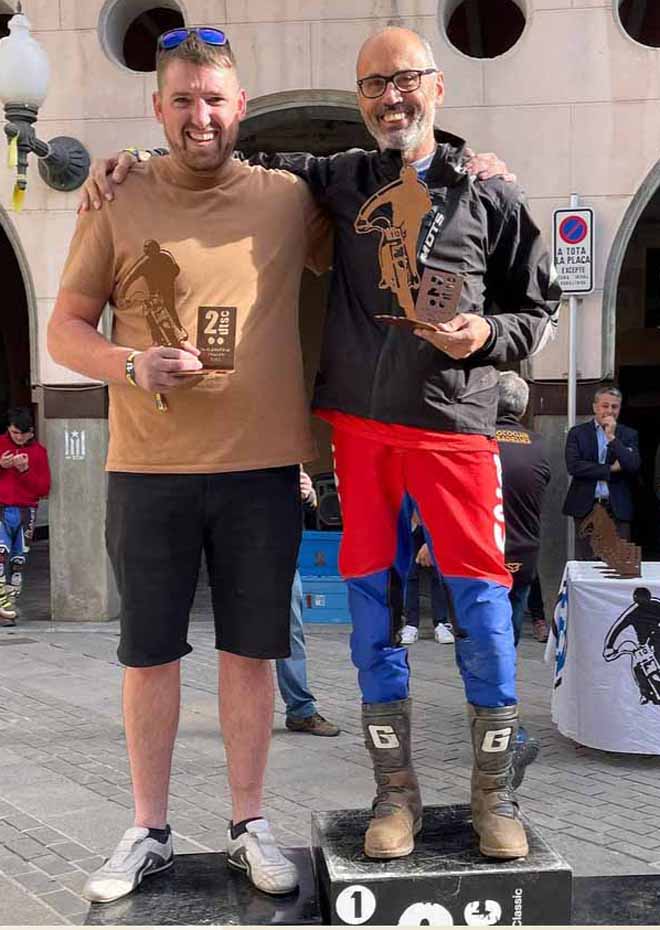
on podium in Santigosa 2023
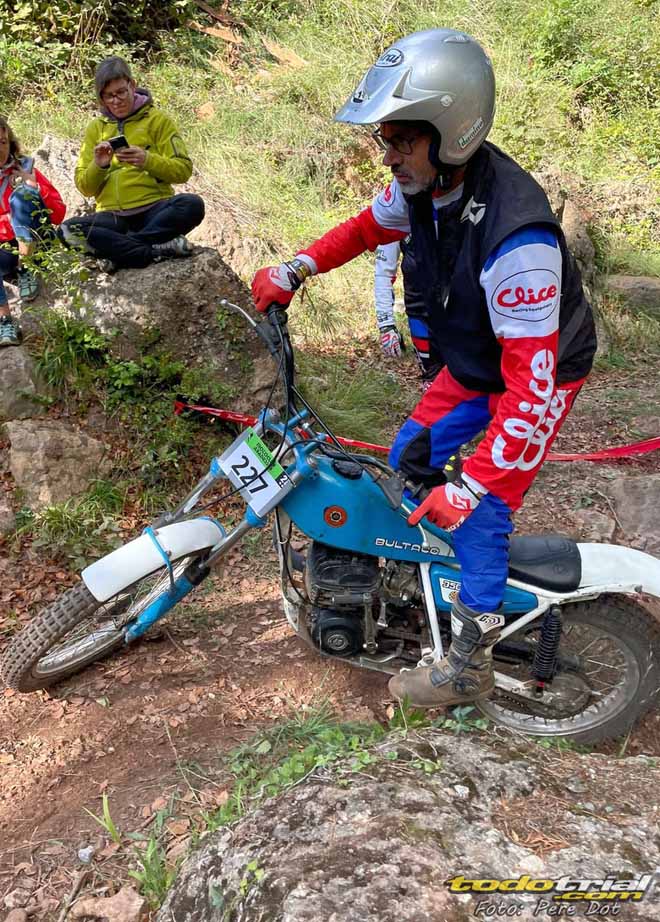
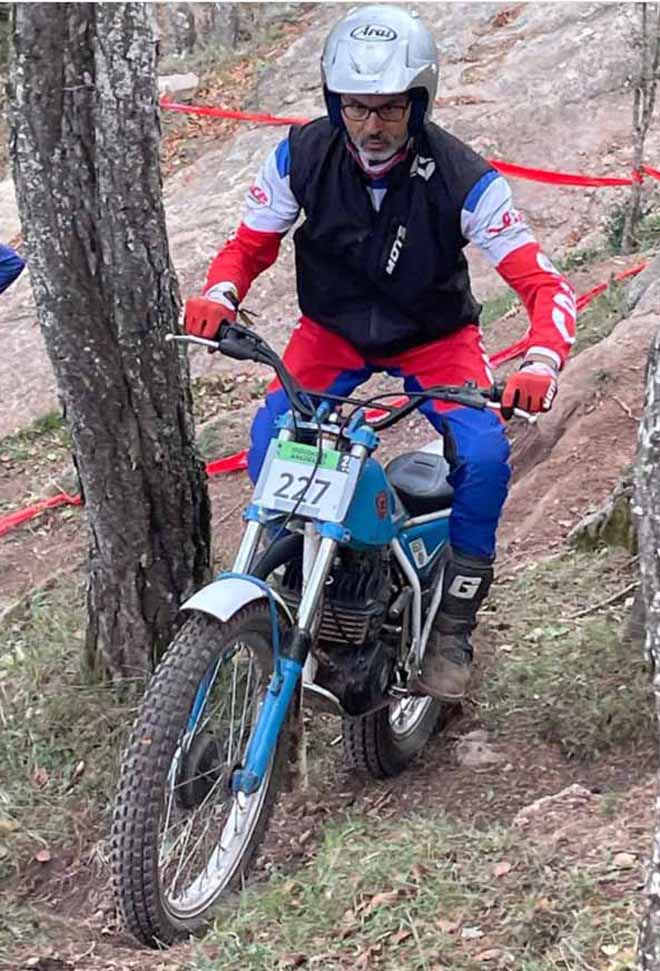
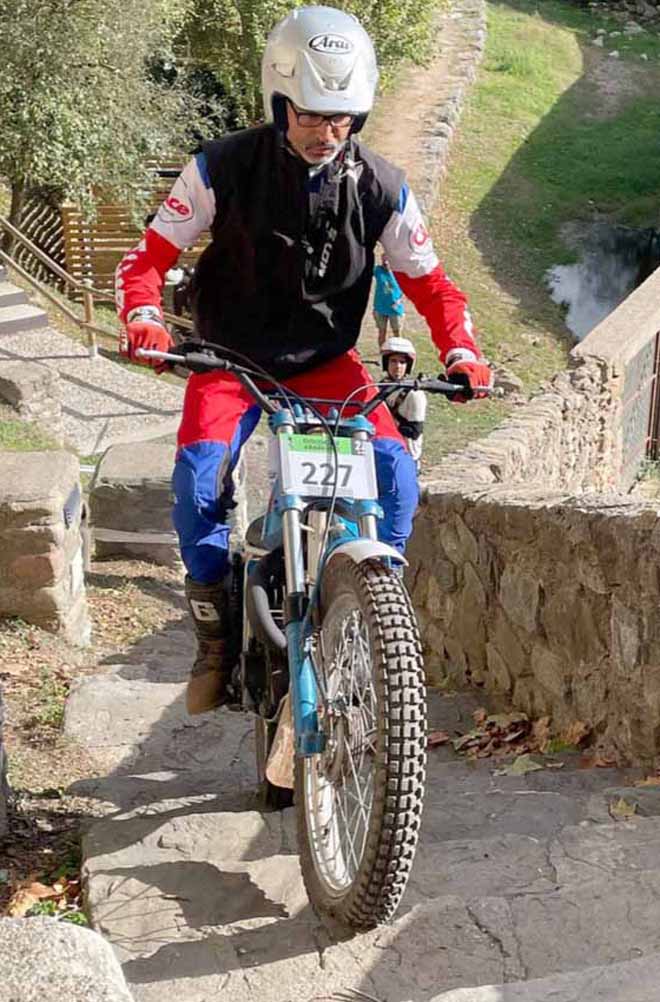

still from Santigosa 2023, the last one is his son Max (photos by TodoTrial.com)
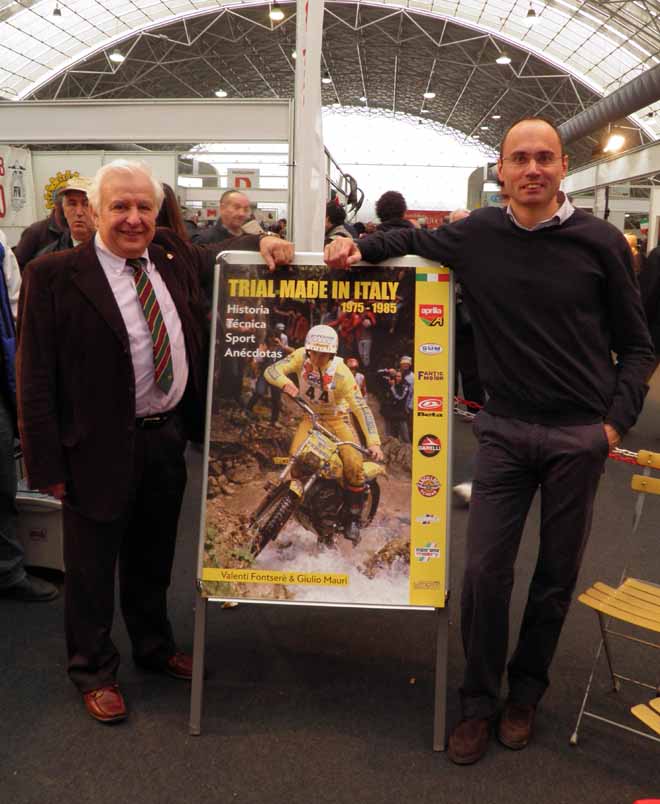
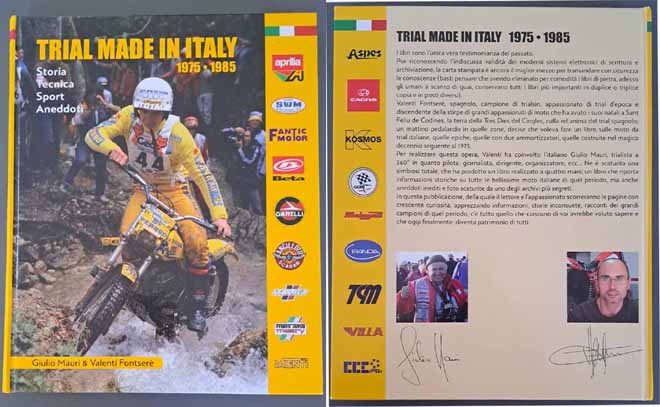
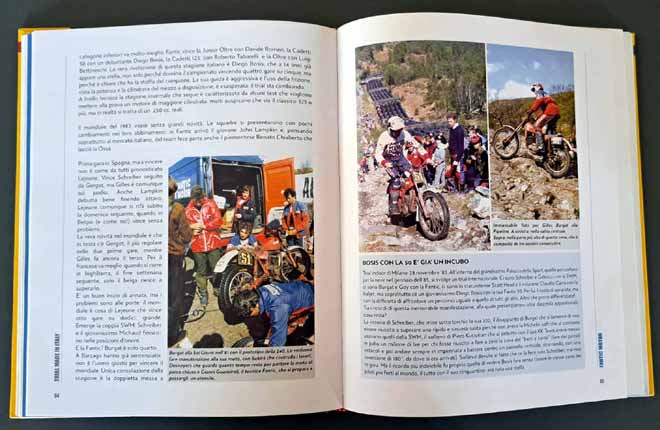
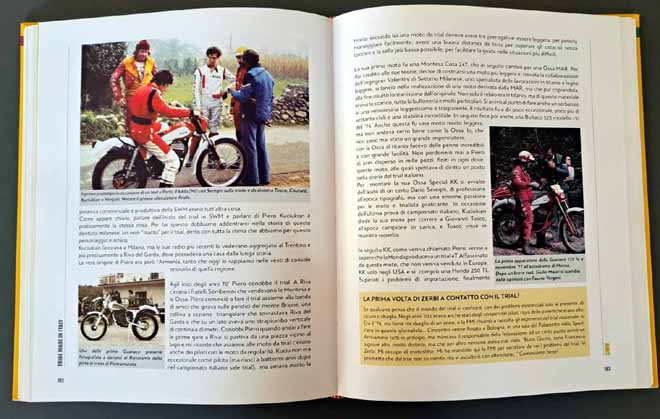
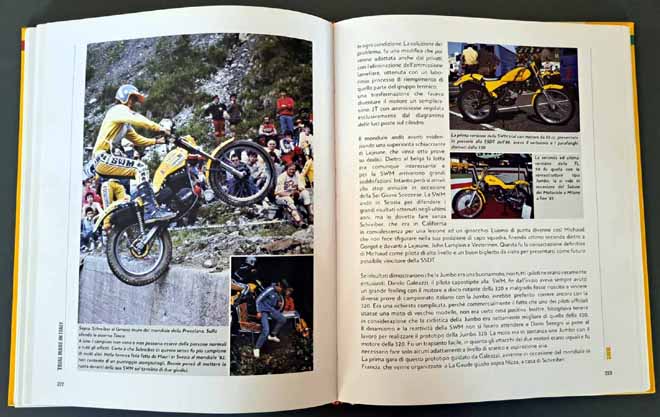
the favolous book, "TRIAL MADE IN ITALY 1975-1985" presented in Novegro (MI) on October,18,2010
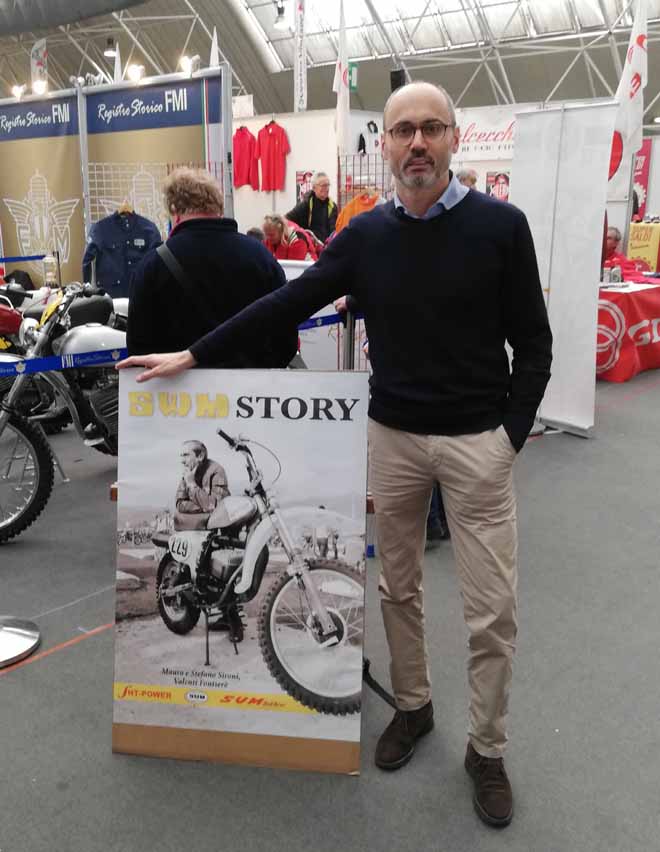
presentation of SWM Story on February,15,2020

first victory in 1980, look at Andreu Codina (first on left)
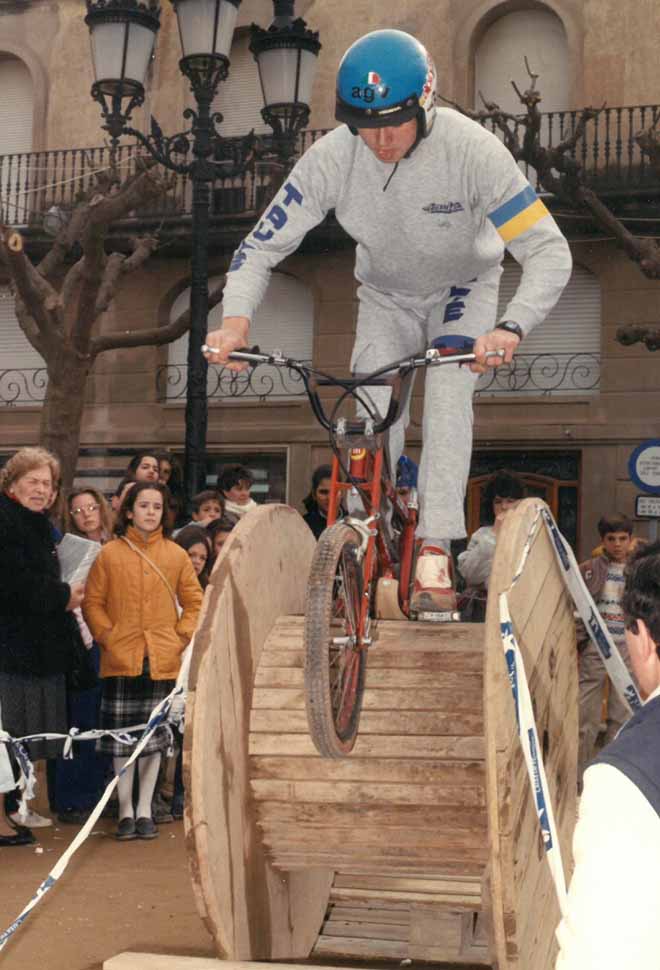
on Trialsin in 1986, Indoor Proto Montesita

in 1986 riding Montesa Cota 200, Tres Dies Cingles


in 1987 riding Gas Gas Halley (frame #12), Tres Dies Cingles
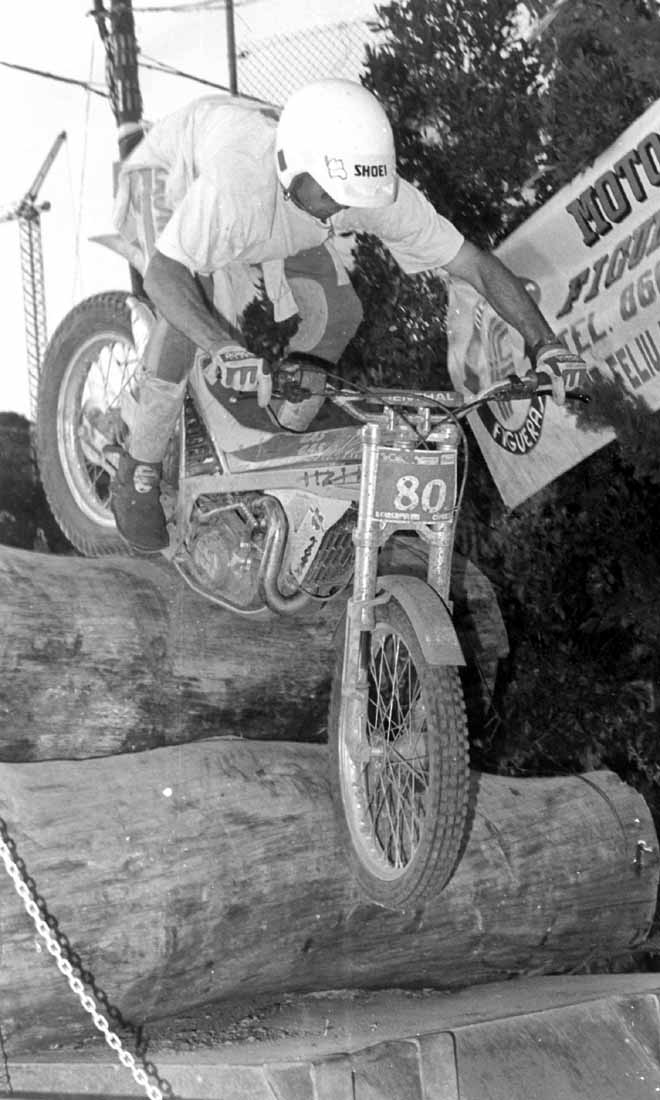
in 1991, Tres Dies Cingles

in 1993, Tres Dies Cingles
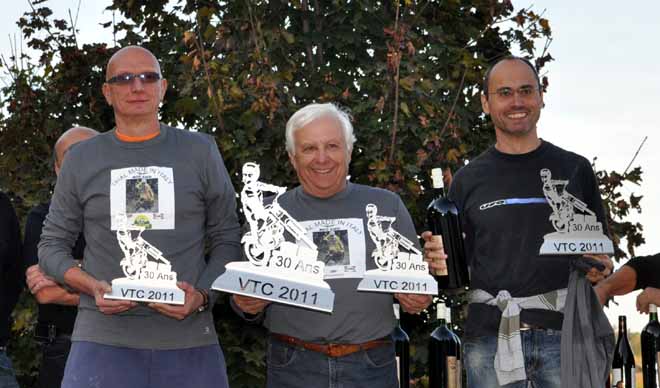
winner in Ventoux 2011, with Giulio Mauri and Mario Candellone

in Ventoux 2011, with his son Max, very young, and Italian champion Ettore Baldini

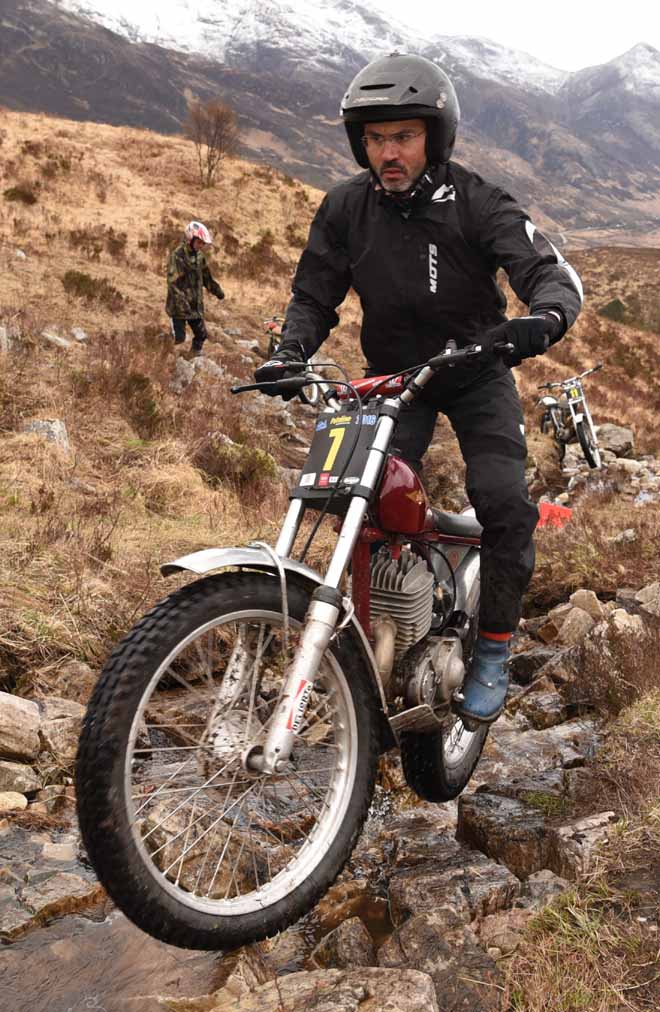
in 2016 riding James of Giulio Mauri, Scottish Pre-65 (photos by John Hulme)
---------------------------------------------------------------------------------------

